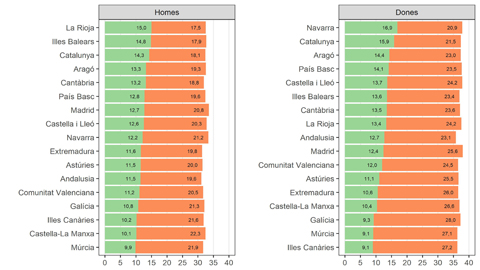Life expectancy in good health increases in regions with higher healthcare spending
Life expectancy in good health after the age of 50 has evolved in accordance to how much is spent on healthcare, according to a study recently published by the UAB Centre for Demographic Studies. The autonomous regions with the highest life expectancy in good health are La Rioja, the Balearic Islands and Catalonia (for men), and Navarra, Catalonia and Aragon (for women). At the bottom of the list are Murcia, Castilla-La Mancha and the Canary Islands (men), and Canary Isalnds, Murcia and Galicia (for women).

An increase in public spending in health of 800 euros between 2006 and 2019 translated into 1.5 years more in life expectancy in good health for men, and 1.2 years for women.
The study on public healthcare spending and life expectancy, entitled “Despesa sanitària pública i esperança de vida: una inversió saludable” and recently published by the Centre for Demographic Studies of the Universitat Autònoma de Barcelona (CED-UAB) in the journal Perspectives demogràfiques, analyses the socio-economic and health factors behind the regional (autonomous communities) differences in life expectancy without illnesses in people over 50 from 2006 to 2019.
The data was collected from six national and European health surveys (2006, 2009, 2012, 2014, 2017 and 2019) and from mortality data provided by the Spanish National Statistics Institute (INE), alongside socio-economic indicators, public health spending figures, human resources and services in the healthcare sector and information on individual health-related behaviours between 2006 and 2019.
The conclusion is that the inequalities in life expectancy in good and bad health after the age of 50 reflects the changes in public healthcare spending undergone by different autonomous communities. The conclusion shows that the more healthcare spending per capita, the more years a person can live in good health and less years in bad health.
The autonomous communities with the highest life expectancy in good health are La Rioja, the Balearic Islands and Catalonia (for men), and Navarra, Catalonia and Aragon (for women). At the end of the list are Murcia, Castilla-La Mancha and the Canary Islands (for men) and the Canary Islands, Murcia and Galicia (for women). However, there are also contrasts: the region with the highest life expectancy of men aged over 50 is Madrid (33.5 years), but it ranks seventh in years lived in good health (12.2 anys).
To calculate life expectancy with and without chronic diseases or illnesses, the most common diseases were taken into account: hypertension, chronic back pain, diabetes, asthma, chronic obstructive pulmonary disease (COPD), cancer, stroke, heart attack and heart diseases.
Several of the indicators analysed showed a significant relationship with the years people lived with or without a disease, including GDP per capita, unemployment among those aged over 55, percentage of the population with only a primary education level or lower, public health care spending per capita, public primary healthcare expenditure per capita, the number of specialist doctors per 1000 inhabitants and the number of specialist nurses per 1000 inhabitants.
However, when all regional factors were taken into account together, the public healthcare expenditure was the variable that best explained differences in life expectancy in good or bad health, both in men and in women.
The evolution of life expectancy in good and bad health and the regional heterogeneity respond to the fluctuations in public health care spending since 2006, marked by the cuts in spending from 2009 to 2014. Although the reduction in spending affecyed all of Spain, there were still important differences among regions. The levels of spending differ greatly among autonomous regions, given that the highest and lowest values reach a difference of 50%.
The analysis concludes that spending 800 euros more per person in public healthcare resulted in 1.5 years more of life in good health in men over 50 and 1.2 years more in women over 50, while it also reduced years lived in bad health by 1.7 years in men and 1.6 years in women.
“Regional healthcare management has an impact on the prevalence and prevention of diseases in people of mature and advanced ages that cannot be overlooked, and this must be taken into account when designing public policies seeking to reduce the burden of diseases among the population. Spending on healthcare, in case anyone doubted it, turns out to be a healthy investment”, affirm Elisenda Rentería and Pilar Zueras, researchers at the CED-UAB and at the Institute for Social and Economic Research at the University of Essex (ISER-Essex), and author of the study.